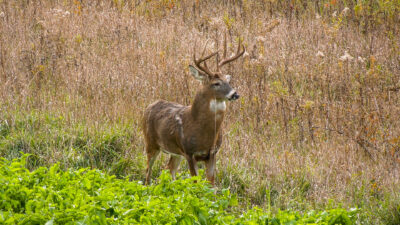As most of you know, plants, whether they are a crop or native vegetation, are “nutrient and energy transfer agents for our wildlife.” The nutrients from the soil and the energy from the sun are contained in the plants. We want that to be transferred to our whitetails, or whatever your preferred species may be. Knowing this, it makes sense for gamekeepers to increase the amount of plants that make the best “nutrient transfer instruments.”
Obviously all of the plants we have aren’t eatable to wildlife, some provide cover and other needs for other vital species. No matter what the plant’s use; food, cover, or other, we want those plants to make the best food, cover, or other they can. That means using all ground at your disposal and pumping the most out of it.
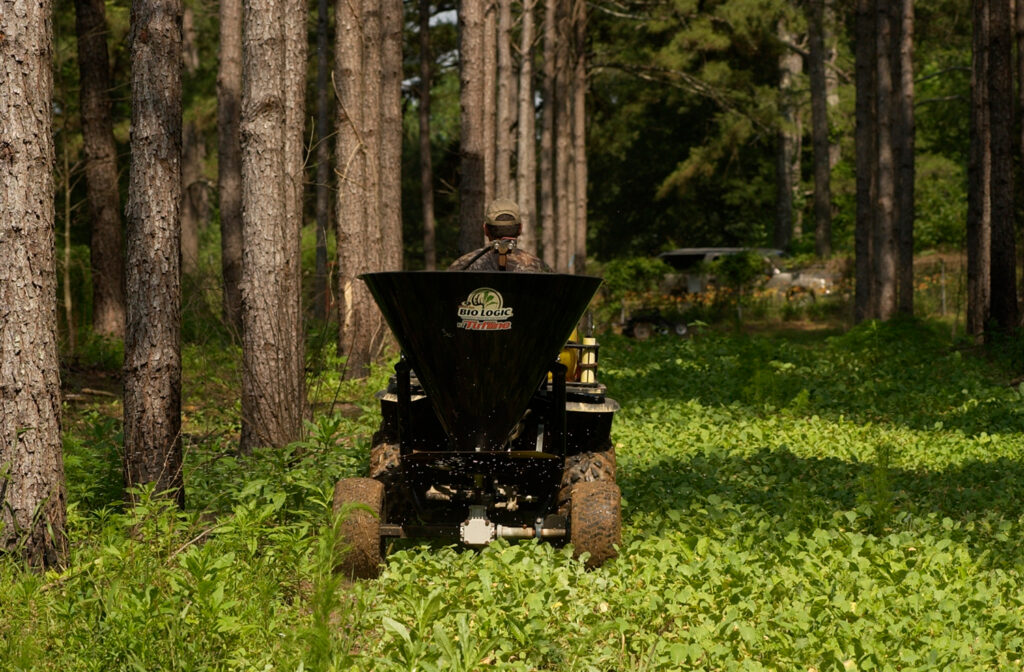
It doesn’t mean burning-out your soil! Two important points are; to keep the carrying capacity consistently below its peak and to make sure your soil stays healthy. This means practicing sound “trigger finger management” (killing enough does to keep the numbers stable) and using soil/plant management routines that keep the soil in a healthy condition.
Certain plants may carry great nutrient levels, but aren’t very digestible in a whitetail’s four-chambered stomach. This is most often measured in TDN (Total Digestible Nutrients) – basically a measurement of how much energy is contained within the forage. With TDN, the higher the number, the better the forage.
Then you would correlate that with the ADF comparison (Acid Detergent Fiber). This is a method to chemically distinguish the readily available cell contents from the less digestible portion of the cell walls. ADF is negatively correlated with digestibility, so the lower the ADF number, the better the quality of forage. This helps us to know how much of a plant converts into energy, warmth and antler for your whitetails, as opposed to how much passes through their system and is expelled out of their back-end, unused.
We have some plants that do well at transferring nutrients to our herd, but they may need different growing conditions than we can provide. With most quality sites and the best soils taken for “cash-crop production,” oftentimes gamekeepers are forced to make the best of what’s left if we want to supplement nutrition to our wildlife. This means we sometimes have to be creative with our tactics.
Anywhere the Sunlight Hits the Soil
I was lucky to learn much from some of the food plot/hunting industry’s most praised and well-known whitetail managers. One of them always told me, “When looking at where to plant food plots on a property, consider ANYWHERE the sunlight hits the soil.” Obviously you must also think about common-sensed things like “can you get your equipment to the spot.” Or maybe it’s like “beach sand” and nothing will grow there. Most often we can change the makeup of the soil, but sometimes it’s not economically practical.
We need somewhere the sunlight hits the soil, but clearly the spot must also receive enough moisture to support a crop. The plants also need nutrients, but as I pointed out, we can amend the soil by adding our own fertilizers and supplements (when it IS economically feasible), so it’s really about finding a spot where the sunlight hit’s the soil.
Easy “Add-ons – Corners, or Your X-wife’s Garden
As long-time GameKeepers readers know, one of my main hunting spots since 2009 had been a 500 acre property I owned in Ontario, Canada. Because of putting all of my management efforts into Canada, since 2009, most of what I had previously installed for food plots on my home property in MN had reverted back to a tangle of native vegetation. I just didn’t have the time to take care of two properties by myself. The opportunity arose and I sold the Canada parcel last year…just a few short months before hunting season.
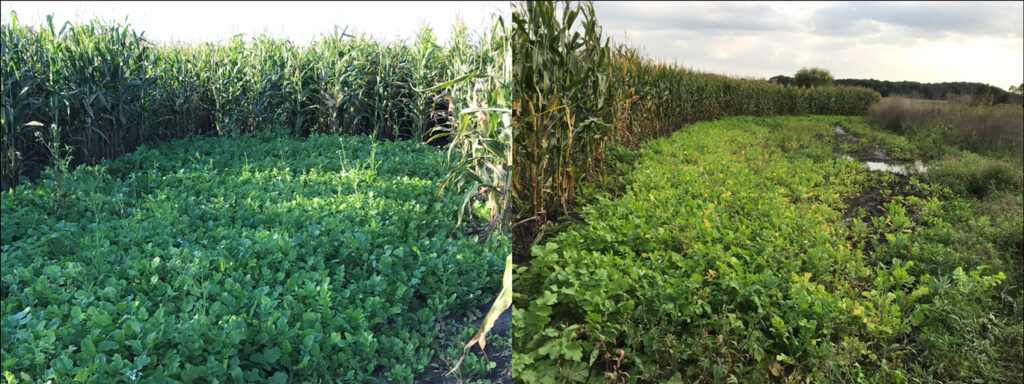
Since we cash-crop our MN farm for corn, soybeans and alfalfa, I could never go out and take the best ground for my food plots or I would have been taking income away from my family. So it had taken me several years to claim and accumulate about 15 acres in food plots back in the 80s and 90s. I always got stuck with the ground that was too wet for the big tractors, or too small for them to bother with.
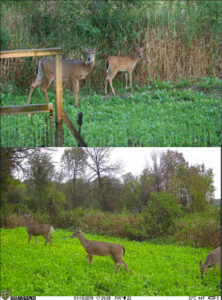
After selling the Canada property I had to scramble to get some food planted back on my home property. Luckily, the cash-crops had been there to back me up, but now with all my previous spots overgrown with native plants and small saplings, I had too much work to do in too little time, so I had to be creative.
I have always been one for using “corners” in agricultural fields where the large tractors have trouble reaching with their big disks and planters. All those small areas add up! Oftentimes you can find spots along a field’s edge, where for one reason or another, the planter didn’t cover or the cash-crop seeds didn’t germinate, but you likely have a clean seed-bed and there was probably fertilizer also applied. Use it!
One of the first places I considered was my X-wife’s vegetable garden. There it sat, open ground…and with a sprinkler system in place, nonetheless. It’s now a ¼ acre food plot! Even though it’s only 75 feet from the back of my home, I couldn’t believe how well it was utilized by numerous whitetails, even during daylight hours. For this first year, I didn’t see any mature bucks use it, but there were several younger bucks and as many as 8 to 10 does would sometimes be feeding all at once in the tiny plot.
Choosing What You Plant
Since I had limited ground, much of what was planted was put into the best producer I know of – brassicas. This is why I mentioned before about TDN and ADF numbers – here are some differences in forages using these comparisons mentioned above. Remember, we want a high TDN and a low ADF.
White Clovers – 24% crude protein, 61% TDN, and an ADF of 23.
Winter Wheat – 17% crude protein, 54% TDN, and an ADF of 30.
Soybeans – up to 44% crude protein, 52% TDN, and an ADF of 36.
BioLogic Brassicas – 36% crude protein, 82% TDN, and an ADF comparison of 13!
What does this mean? While the other plants are great whitetail foods, and variety is important in a food plot program, there is simply nothing else that compares to what brassicas can provide. Not only do they have off the chart nutrient levels, but when a whitetail consumes them they gain maximum benefit from the energy and nutrients. Brassicas can also be over-seeded in many soil types so you don’t have to turn the soil again – perfect for along the edge of crop fields that have already been planted in a cash-crop. Combine all that with the fact they are also the best tonnage producer, most hardy and easy to plant, and you begin to see why I believe this is the best deer food God has ever given us.
Roads & Trails, Logging Landings and Fire-Breaks
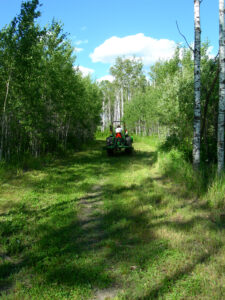 Long, skinny “food plots,” like roads and trails can really add to your program’s “bottom line.” Because these spots most often have limiting factors like amount of sunlight reaching the soil (because they’re often in areas with a timber canopy) and the fact that they may be driven over, it makes our planting choices more limited.
Long, skinny “food plots,” like roads and trails can really add to your program’s “bottom line.” Because these spots most often have limiting factors like amount of sunlight reaching the soil (because they’re often in areas with a timber canopy) and the fact that they may be driven over, it makes our planting choices more limited.
Clover Plus is my go-to planting for these cases. A perennial blend like this should withstand being driven over periodically and can do well in as little as 4 to 6 hours of direct sunlight per day.
Certain parts of a trail might get enough sun, while other parts aren’t good for growing anything. Consider the aspect to the sun. A good rule of thumb is; if there’s something currently growing in the spot, like weeds or grass, that indicates there is likely enough sunlight to grow a perennial blend.
Often another limiting factor when planting roads and trails will be the inability to turn the soil. It may be because of the nearby trees and their roots preventing it, or it might be simply because it makes for a bumpy trail and can lead to erosion. Especially if you have acidic soil, ideally you’d want to work some lime into the top 6 to 8 inches to reduce the acidity. Pelletized lime applied on the surface should help somewhat, but if you can’t bring the pH close to neutral, don’t expect to get as long out of the perennial stand.
Double-Cropping
Basically “double-cropping” is getting two crops out of the same soil during one growing season. I like to do this with an annual legume like Protein Peas, or Roundup Ready soybeans as the spring crop. Then, most often a late-summer over-seeding of brassicas will be my choice, but you could use other small-seeds that only need to make contact with your soil, like clovers or some cereals.
As the beans are maturing, the brassicas, or whatever else you choose to over-seed or plant in their place, will hopefully control weeds, diseases and pests. Basically, you want to practice sound “crop rotation,” but it’s all done during the same growing season. By planting the two crops you’re hoping to break the life cycles of any disease or pests and replenish some nutrients. Ideally, whatever you’re companion crops are; one will provide what the other might be lacking and vice versa.
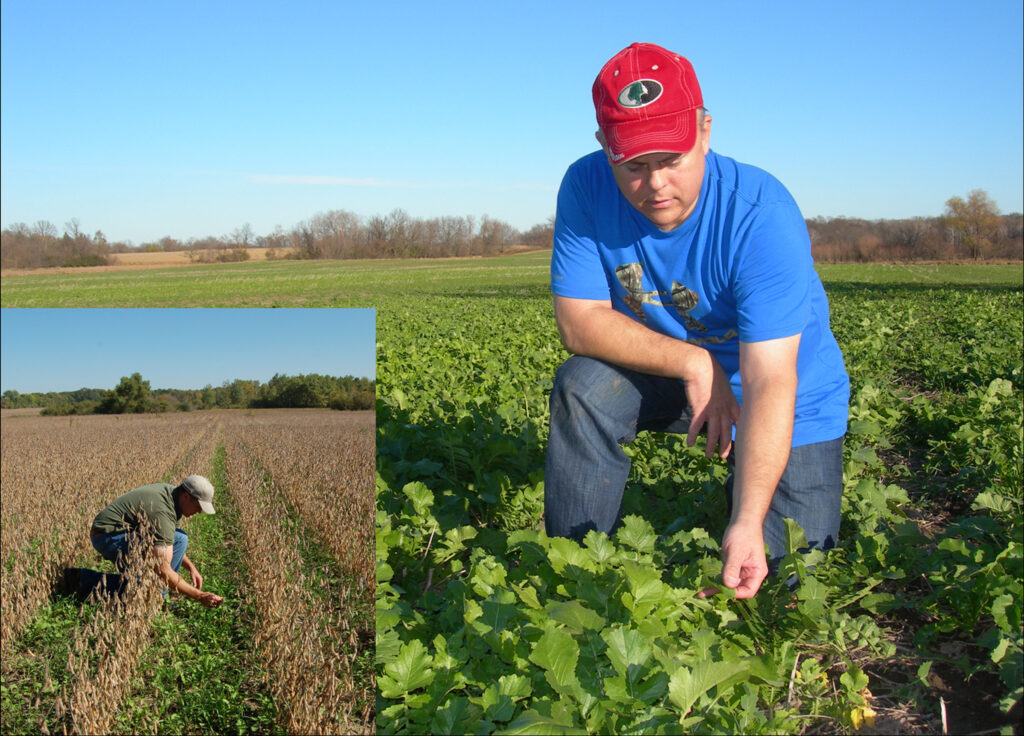
Legumes are often used as one of the plants because of their benefits to the soil. However, daikon radishes, like our Deer Radish, also have huge soil amending capabilities. My favorite “double-crop plot” would be a spring planting of Roundup Ready soybeans and then over-seeding it in early July (before the beans get too tall in MN) with Deer Radish.
This can be done on some cash-crop corn and bean fields. With corn I only concentrate on the rows running in a direction or on a slope where they will receive adequate sunlight, or around the outside of the field. However soybeans are a different story. Obviously there are numerous groups of soybeans with varying maturation lengths and different growth characteristics, but overall, soybeans will mature, lose their leaves and be harvested earlier than corn. This gives more time and better conditions (more sunlight) for your second crop (like brassicas) to come shooting out with prolific growth.
Thinned Pine Rows
I don’t see many folks planting thinned pine rows in the north, but it’s a preferred method of many on the large pine plantations in the south and it can be an effective way to add food and a great place to set up an ambush for hunting season.
“Row thinning” involves removing entire rows of trees, typically every third or fourth row. This will make the necessary room for logging crews to remove trees from the other rows within the plantation when commercial harvest begins. In the time-being, this ground makes for a place to plant food plots. This “pre-commercial thinning” often occurs when the trees reach about 6 inches in diameter, usually sometime after about 8 to 14 years of growth.
I don’t think removing stumps is necessary; we’re planting this for deer/wildlife, not for harvest. Simply spray the existing vegetation, rake or harrow the dead vegetation off of the plot (the thinned row) so the planted seed will make contact with the soil, disk, then broadcast your seed and the correct amount of lime and fertilizer for your desired crop.
The partial sunlight that the pines allow should give enough light for a good crop, yet the partial shade helps to conserve soil moisture. Whitetails are very comfortable feeding in these locations because they are a couple hops away from cover. The remaining pines usually make it easy to find a suitable ambush location and the long, narrow channels help to direct the wind in a consistent direction.
Fertilize
If it’s not in the soil, it can’t be transferred to your plants and then onto your whitetails. As we continually preach at GameKeepers, always do a soil test and apply the results for your specific crop to the soil. I highly recommend doing a complete soil test (not just the basics of P, K, Ca and Mg) every so often. The micronutrients are also important and are often overlooked.
Native plants can also be fertilized, and if it’s in your budget, they should be. Concentrate on the plants that benefit whitetails, especially those that produce green, leafy forage. Foliar applied fertilizer works great for this. Preferred woody browse species can also be fertilized.
Many managers have enough ground available so they don’t have to worry about tweaking things to pull the most out of every spot, but even as such, some of these tactics can help you and your wildlife in other ways, and most can benefit your soil. And remember…every little bit helps.

